WooCommerce Product SEO Techniques: Step-by-step Guide

WooCommerce, a popular plugin for building online stores on WordPress, offers a robust platform for selling your products.
Just like any other website, WooCommerce also needs good Search Engine Optimization (SEO) practices. SEO helps to improve your website’s visibility and drive potential customers to find your products and services.
In this write-up, we’ll explore the comprehensive techniques to implement WooCommerce product SEO to increase conversion rates, sales, and ultimately, grow your online business!
Understanding WooCommerce Product SEO
WooCommerce Product SEO is the process of optimizing individual product pages and shop pages within a WooCommerce-powered online store. The main objective of WooCommerce Product SEO is to boost visibility in search results to drive more organic traffic and sales.
Key components of WooCommerce product SEO
Before getting started, you need to understand the basic components of WooCommerce products affected by search engine optimization. Here are the 5 key components of WooCommerce product SEO:

✨ Product Titles
WooCommerce product titles should be concise and meaningful. Always avoid generic terms and prioritize specific phrases that accurately represent your product. Rather, you should use relevant WooCommerce product keywords for search engine optimization.
This title not only describes the product but also includes key attributes and target keywords that visitors might be interested in or searching for.
✨ Product Descriptions
Next, write compelling and informative product descriptions showcasing your WooCommerce product’s features and details. Plus, focus on providing value to potential customers while optimizing for search engines.
✨ Product Categories and Tags
WooCommerce product category SEO is also important. You should organize your products into clear categories and tags to improve both user navigation and SEO. Optimizing WooCommerce category SEO helps search engines understand the structure of your site. On the other hand, WooCommerce product tags SEO enhances discoverability within specific topics or themes.
✨ Product Images
Many of us neglect or are unaware of this, but product image optimization is the crucial element in terms of WooCommerce Product SEO. Use descriptive file names and alt texts that include targeted keywords. Also, compress images to improve page load speed. It will enhance both user experience and SEO performance.
Plus, describe the image accurately, such as “Front view of men’s slim-fit blue t-shirt” in the ALT text.
✨ Product URLs
WooCommerce product URLs should be clean and concise. Try to include relevant keywords naturally. And, avoid long strings of numbers or irrelevant characters in the URLs.
It will be easy to read and understand for both buyers and search engines.
➡️ Want to begin a t-shirt business without much coding knowledge? Check out this step-by-step tutorial to start a t-shirt business with WordPress.
WooCommerce Product SEO Techniques: Complete Guide

Simply having a well-designed website or a visually attractive online store isn’t enough to guarantee success. You have to implement a solid SEO strategy to stand out among millions of websites.
Here’s a comprehensive guide to WooCommerce product SEO techniques:
1. Keyword Research for WooCommerce Products
Keyword research is the cornerstone of any effective SEO strategy, especially for WooCommerce products. By identifying relevant keywords, you can optimize your shop pages and product pages to rank higher.
To conduct keyword research for your WooCommerce products, you can follow the following steps:
Identify Relevant Keywords
Start with identifying keywords directly related to your products. These can include product names, model numbers, and specific features.
Next, you should consider broader keywords related to the category or niche your products belong to.
After that, you need to think about what users may search for when looking for products like yours. Also, find out relevant user reviews, comparisons, or specific use cases for your WooCommerce store.
Here is a quick example of identifying relevant keywords:
- Product Name/Keywords: “ABC Air Zoom Pegasus 38”, “ABC Ultraboost 21”
- Category Keywords: “men’s running shoes”, “women’s running shoes”
- User Intent Keywords: “best running shoes for flat feet”, “lightweight running shoe reviews”
Select Long-tail and Short-tail Keywords
Short-tail keywords are shorter, generic keywords. You can select short-tail keywords to attract broader traffic with higher competition. On the other hand, long-tail keywords target specific and lower-competition queries, maximizing visibility and relevance for diverse user intents.
Selecting both long-tail and short-tail keywords for WooCommerce SEO ensures a balanced approach in terms of WooCommerce product SEO.
- Short-tail Keyword example: “Running shoes”
- Long-tail Keyword example: “Women’s lightweight running shoes with arch support”
Utilize Keyword Research Tools
Finding keywords on a large scale for your WooCommerce store is not possible manually. Several tools can help you conduct keyword research for your WooCommerce products. For example, you can use tools like Google Keyword Planner, Semrush, Moz, etc.
Also, you can utilize AI-powered keyword research assistants i.e. GetGenie AI to get insights into keyword search volumes, competition levels, and other parameters.
2. On-Page Optimization Checklist for WooCommerce Products

On-page SEO involves optimizing individual web pages to enhance their search engine rankings and attract organic traffic. You can follow the following checklist to optimize WooCommerce product pages.
Optimizing product titles for SEO
- Include primary keywords at the beginning of the title.
- Keep titles concise, descriptive, and relevant to the product.
Crafting compelling titles
- Create WooCommerce product titles that grab attention and accurately represent the product’s value proposition.
- Use powerful words and action-oriented language to entice clicks.
Writing SEO-friendly product descriptions
- Provide detailed and unique descriptions that highlight product features, benefits, and use cases.
- Using AI in WooCommerce can maximize your productivity as well as conversion rates. You can utilize AI-powered WooCommerce product description writer tools like GetGenie AI to generate SEO-optimized short and long product descriptions.
Optimizing product categories and tags
- Use descriptive and relevant categories and tags.
- Ensure categories and tags are organized logically and hierarchically for easy navigation.
Incorporating keywords naturally
- Use keywords naturally within product titles, descriptions, and meta tags.
- Avoid keyword stuffing and ensure keywords are seamlessly integrated into content.
- Focus on creating engaging and helpful content that addresses user intent.
Organizing products effectively on the shop page:
- Utilize categories, filters, and sorting options to enhance user experience.
- Showcase best-selling or featured products prominently.
Implementing internal linking:
- Link product pages to related content within your website.
- Use anchor text that includes relevant keywords for internal links.
Enhancing product images for SEO:
- Optimize images for the web by choosing appropriate file formats (e.g., JPEG for photographs, PNG for graphics).
- Use descriptive filenames, and ALT text that include keywords relevant to the product.
Let’s have a look at the example below for each step of the on-page optimization techniques for WooCommerce Products:
- Optimizing product titles for SEO
- Before: Running Shoes
- After: ABC Air Zoom Pegasus 38 – Men’s Lightweight Running Shoes
- Crafting compelling titles
- Before: Running Shoes
- After: Conquer Every Mile with ABC Air Zoom Pegasus 38 – Shop Now!
- Writing SEO-friendly product descriptions
- Before: This is a running shoe
- After: Experience ultimate comfort and performance with ABC Air Zoom Pegasus 38, featuring responsive cushioning and breathable mesh upper for your daily runs.
- Incorporating keywords naturally
- Before: Buy our running shoes. Best running shoes for men.
- After: Get the best out of your runs with our ABC Air Zoom Pegasus 38, designed for men seeking lightweight, supportive footwear for their active lifestyle.
- Optimizing product categories and tags
- Category: Men’s Running Shoes
- Tags: ABC, Running Shoes, Men’s Footwear
- Organizing products effectively on the shop page
- Featured Category: Best Sellers
- Featured Product: ABC Air Zoom Pegasus 38 – Men’s Lightweight Running Shoes
- Implementing internal linking:
- Within Product Description: You can use links to relevant products in the description like “Pair your ABC Air Zoom Pegasus 38 with our performance running socks for the ultimate comfort during your workouts. Insert the sunning socks URL with the text <performance running socks> as a hyperlink.
- Enhancing product images for SEO:
- Image Filename: ABC-air-zoom-pegasus-38-men’s-running-shoes.jpg
- Alt Text: ABC Air Zoom Pegasus 38 – Men’s Lightweight Running Shoes in Black/White”
- Compressed Image Size: Reduced image size using TinyPNG from 950KB to 50KB for faster loading on web pages.
3. Technical SEO Steps for WooCommerce Products

Technical SEO is a way to optimize the infrastructure and settings of your WooCommerce website. It helps to improve search engine visibility and performance.
Here’s a quick checklist of technical SEO steps for your WooCommerce product pages.
Creating SEO-friendly URLs
- Use descriptive keywords in URLs for product pages.
- Avoid using dynamic parameters and unnecessary characters.
Improving site speed for better SEO
- Utilize caching plugins to speed up website performance.
- Optimize images and minimize JS and CSS files for faster rendering.
Implementing schema markup for products
- Use WooCommerce product structured data markup or WooCommerce product schema to provide search engines with detailed product information.
- It will enhance search engine visibility by marking up WooCommerce product details such as price, availability, and reviews.
Enhancing search engine visibility
- Ensure proper indexing of product pages by submitting XML sitemaps to search engines.
- Monitor crawl errors and fix issues to maintain search engine visibility.
Adding Breadcrumb markups
- Implement breadcrumb navigation for easy navigation and improved user experience.
- Use WooCommerce product schema markup to enhance breadcrumb visibility in search results.
Ensuring device-responsive design
- Design and optimize your WooCommerce store to be responsive across all devices.
- Test and ensure seamless user experience on different browsers and devices (mobile, tablet, and desktop)
4. Off-Page Optimization Methods for WooCommerce Products

Off-page optimization for WooCommerce products is the strategy implemented outside of your website to improve its search engine rankings and online visibility.
Let’s explore some effective methods for off-page optimization specifically for your WooCommerce products.
Building quality backlinks to product pages
- Acquire backlinks from reputable websites and blogs related to your product niche.
- Focus on earning natural backlinks through high-quality content and outreach efforts.
Guest blogging
- Contribute guest posts to relevant blogs in your industry.
- Include backlinks to your product pages within the guest posts to drive traffic and improve SEO.
Influencer collaborations
- Partner with influencers in your niche to promote your products.
- Collaborate on sponsored content or product reviews to reach a wider audience and gain exposure.
Use Social media for product promotion
- Share product updates, promotions, and customer testimonials on social media platforms like Instagram, Facebook, and Twitter.
- Engage with your audience and encourage user-generated content by running contests or featuring customer photos.
Sharing product links
- Share product links on relevant forums, communities, and online marketplaces.
- Participate in discussions and provide valuable insights to establish credibility and attract potential customers.
Encouraging user-generated content
- Encourage customers to leave reviews and testimonials on your product pages.
- Showcase user-generated content, such as photos, videos, and use cases to build trust and credibility with potential buyers.
5. Monitoring and Measuring WooCommerce Product SEO
Monitoring and measuring performance is one of the SEO best practices for WooCommerce products. These also help in evaluating the success of your website and content optimization strategies.
Here’s how to effectively track and analyze the performance of your SEO efforts for WooCommerce products:
Tracking keyword rankings
- Monitor keyword rankings regularly using tools like Semrush or Google Search Console.
- Track progress and identify opportunities for improvement in search engine rankings.
Using SEO tools for tracking
- Utilize SEO tools to track website performance, keyword rankings, and backlink profiles.
- Analyze data to identify SEO trends and make informed decisions for better optimization.
Analyzing website traffic and conversions
- Use Google Analytics to track website traffic, user behavior, and conversion metrics.
- Analyze data to understand which keywords and pages drive the most traffic and conversions.
Tweaking product titles and descriptions
- Monitor the performance of product titles and descriptions in search results.
- Perform A/B tests and make adjustments to optimize for better click-through rates and conversions.
Making adjustments based on analytics data
- Review analytics data regularly to identify areas for improvement.
- Adjust SEO strategies, content, and targeting based on performance metrics and user behavior.
Importance of SEO for WooCommerce Products
Now, you can be asked, why actually you should focus on product SEO for your WooCommerce online store. Does it truly add any value to the overall returns?
Well, implementing proper SEO for WooCommerce products offers a multitude of benefits:
🚀 Boosts Visibility and Traffic
SEO-optimized eCommerce product pages are more likely to rank higher in search engine results. It will bring more visibility and drive organic traffic to your online store.
📈 Provides a Competitive Edge
By outranking competitors in search results, you gain a competitive advantage. At the same time, you can attract potential customers who are actively searching for products like yours.
🎯 Enhances User Experience
Around 68% of people initiate their online experiences with a search engine!
WooCommerce SEO optimization improves site structure, navigation, and overall user experience. It’ll lead to higher engagement and customer satisfaction.
💰 Drives Increased Sales
Higher visibility and improved user experience translate into more conversions. That results in increased sales revenue for your e-commerce business.
✅ Ensures Long-Term Growth
Consistent SEO efforts result in sustainable growth by establishing your site as a reliable and authoritative source within your industry or niche.
FAQs
WooCommerce Product SEO: Final Words
To sum up, proper WooCommerce product SEO can ensure your products stand out in the online crowd. Here we’ve discussed the effective SEO techniques (on-page, off-page, technical SEO) for your WooCommerce products. These methods are well-proven and essential to grow any online store.
So, focus on search engine optimization to attract as well as convert more customers and growth in the online market.

